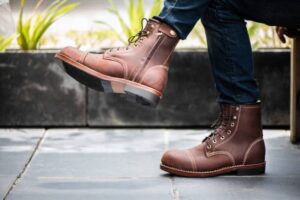Flat Boots: Buying and Selection Tips
Choosing the right pair of brown flat boots is key to keeping your feet comfortable and healthy. Whether you’re heading out on a bonefish trip or simply walking to your car and work, the proper fit is critical.
A tight boot can put unnecessary stress on your feet. It’s important to test the fit, including how tightly they lace and where they bend.
Determine Your Foot Type
 One of the most important things to consider when buying boots is your foot type. While this may not seem like a big deal, it can actually make a big difference in your comfort levels and even your risk of injury. Having the right shoe for your foot type will prevent you from squeezing your feet into ill-fitting shoes that can cause pain, chafing, and, in extreme cases, even damage to your tendons.
One of the most important things to consider when buying boots is your foot type. While this may not seem like a big deal, it can actually make a big difference in your comfort levels and even your risk of injury. Having the right shoe for your foot type will prevent you from squeezing your feet into ill-fitting shoes that can cause pain, chafing, and, in extreme cases, even damage to your tendons.
Fortunately, determining your foot type is a simple process. All you need to do is get a piece of paper and wet it, then step on it with your foot. If the middle part of your footprint has an indent, you have normal or flat feet. If the impression you leave is almost entirely flat with little or no arch, then you have high arches. In this case, you probably pronate, meaning that your feet roll inward when walking or running, putting you at risk for injuries such as plantar fasciitis.
Alternatively, you can also look at the wear patterns on your current shoes to determine your foot type. If the inner soles are worn down more than the outer ones, then you have neutral or pronator feet. If the opposite is true, then you likely have supinator feet, which means that your feet land flat and don’t absorb shock well.
Try On Different Boots
Boots come in many styles and heights, so a little experimentation is often needed to find the right pair. Regardless of what style you choose, brown flat boots should fit snugly around the foot and toes with just enough room to move your toes comfortably and no more than a quarter to half an inch of slippage at the heel. This slippage is normal and can help the boot conform to your feet as you walk.
Flat boots have made quite a name for themselves in the fashion world this season. From leather knee-highs to lace-up combat boots, they’re all over the runways and have been paired with everything from easy-going knit dresses to cool leather jackets. While this trend is fun to explore, it’s important not to go too extreme when choosing a pair of boots that can take you from work to play and back again.
It’s always a good idea to try boots on in the afternoon when your feet are at their largest and to ensure that they can be worn with thick socks. It’s also a good idea to test the fit of boots on soft indoor surfaces such as carpeting or a tiled floor. In addition to this, boots can often run a bit differently than shoes, so you may need to size up or down depending on your preference for fit and the width of your feet.
Consider Your Activity Level
When you’re looking for the perfect pair of boots, it’s important to consider what activities you’ll be doing in them. It can help you determine what features you’ll want, such as comfort and arch support.
For instance, if you’re planning on wearing your boots for long walks or sightseeing trips, then you’ll want to make sure they have comfortable, cushioned insoles and sturdy outsoles. You’ll also want to make sure the boots are easy to get on and off and that they fit well around your calves.
On the other hand, if you’re planning on wearing boots for work or to protect yourself from environmental hazards, then you’ll need a more rugged, protective style. Look for boots with high rubber soles and protective toe caps that can keep your feet safe from falling debris or sharp objects.
Finally, if you’re buying brown flat boots for work or to protect yourself from environmental hazards then you should consider if they meet any safety standards. For example, if you’re a welder or bricklayer, then you’ll want to buy a pair of boots with a protective toe box and electrical hazard protection. Also, if you have diabetes, then you may need to purchase a special insole that helps with foot pain and neuropathy associated with diabetes. Fortunately, there are plenty of boot options on the market for any situation or purpose.





Comments are Disabled